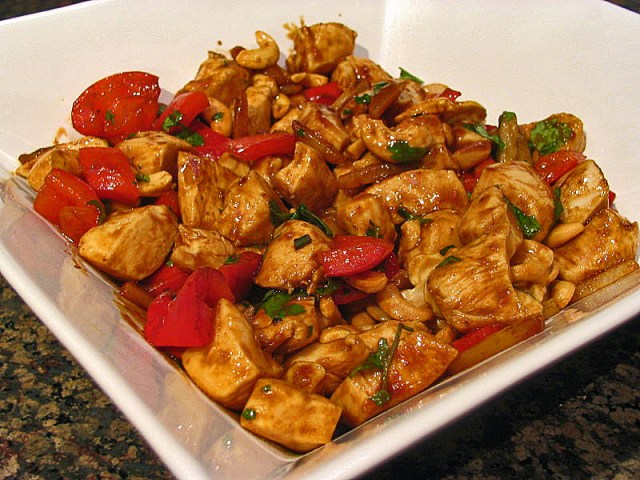Last week I finished my third year of Mandarin, a challenging but rewarding journey! To celebrate, I prepared a Chinese recipe for our dinner. Cookbooks and websites sometimes mistreat ethnic cuisines: too often it’s enough to finish a stir-fry with some soy sauce, cornstarch and then label it Chinese. For the alternate, informed approach I reached for Barbara Tropp, who was to Chinese cooking what Julia Child was to French cuisine: she studied it to the point of becoming an expert, and shared her knowledge through excellent writing. Barbara Tropp’s “Modern Art of Chinese Cooking” is a culinary masterpiece like no other on the subject, and if you have genuine interest in learning to prepare authentic Chinese dishes, you’ll need this book.
Here is what Tropp said about the recipe I chose:
“Subtly sweet and rich, with a classic contrast of velvety chicken, slippery-crisp vegetables and crunchy nuts, it combines every technique you need to know to produce elegant, restaurant-style stir-frys. The taste explosion that makes this dish so appealing is a multi-regional affair. Hoisin is a predominantly north Chinese condiment, chili is a Szechwanese touch, while wine used as it is here is an Eastern taste.”
I love it when a cookbook writer goes beyond providing recipes. I am still saddened by her unfortunate death when she was only 53 years old.
HOISIN-EXPLOSION CHICKEN
(adapted from Barbara Tropp)
1 pound chicken breast, cut in bite size pieces
1 large egg white
1 Tablespoon Chinese rice wine
1 tsp Kosher salt
4 cups water + 2 tsp peanut oil
1/2 cup whole blanched almonds or cashews
1 medium red bell pepper
6 ounces bamboo shoots, sliced
fresh cilantro leaves
Aromatics
2 tsp garlic, finely minced
1 Tablespoon minced ginger
1 Tablespoon finely minced green onions
1/4 tsp dried red chili flakes
Liquid seasoning
3 Tablespoons hoisin sauce
1 + 1/2 Tbs Chinese rice wine
2 tsp soy sauce
Mix the egg white, wine and salt and process until smooth and thick (30 to 60 seconds) in a food processor or blender. Place the chicken in a bowl and add the egg white marinade over it, tossing well to completely coat the pieces. Refrigerate from 8 to 36 hours, the longer the better.

Toast the nuts in a 350F oven, or by gently frying them with a little bit of peanut oil on a non-stick skillet. Do not allow them to burn. Reserve.
Cut the seeded red bell pepper into squares. If using canned bamboo shoots, rinse them well and blanch for 10 seconds in boiling water – this will refresh their taste. Cut in thin slices. The veggies and nuts can be prepared one day in advance. Mince the cilantro right before finishing the dish.
Combine all aromatics and mix well in a small bowl. Mix all the liquid seasonings in another small bowl. Reserve both.
Velveting the chicken:
Bring the water/oil to a simmer, do not allow it to go into full boil. You want to see small bubbles forming around the rim of the water. Stir the chicken to loosen the pieces slightly, and drop them in the water, stirring to separate them. Simmer until they are about 80% cooked – this should take about 20 seconds. It’s important not to over cook the meat. When in doubt, cook less. Remove the pieces to a plate with a slotted spoon. Once velveted, the meat must be stir-fried right away.
Finishing the dish…
Heat a wok over high heat until hot enough to evaporate a bead of water on contact. Add 2 tablespoons of oil and swirl it to glaze the bottom of the pan. When the oil is hot enough to sizzle one piece of bell pepper, add the peppers and the bamboo shoots to the pan, stir frying them briskly until they are evenly glossed with oil and heated through, about 1 minute. Remove the vegetables to a dish. Return the wok to the stove, add the remaining tablespoon of oil and swirl to coat the pan. Add the aromatics, stir until fragrant, 15-20 seconds, add the liquid seasonings, and stir to combine. Add the velveted chicken pieces and the vegetables, toss quickly to cook through, about 30 seconds. Turn off the heat, add the nuts and the cilantro. Adjust the seasoning and serve over white rice.
ENJOY!
(receita em portugues na proxima pagina)
to print the recipe, click here
Comments: This recipe calls for an important step in the meat preparation for stir-frying: “velveting.” Tempting as it might be to skip it, don’t do it: the improvement in the texture will shock you! You’ll use an extra pan and spend a few more minutes in the overall preparation, but it is a small price to pay for textural perfection. Barbara Tropp’s recipes are quite detailed, often extending over several pages, which some people may find a bit excessive. I have a small dry-erase board on which I write down a condensed version of the recipe to take to the kitchen. Interestingly enough, I originally got the board to practice writing Chinese characters, so using it for Chinese cooking seems like a natural move… 😉
I’ve made this recipe with water chestnuts instead of bamboo shoots, snow peas in addition to bell peppers, and peanuts instead of cashews. You can adapt it to what you have available, as long as you preserve the basic techniques. Like all stir fry recipes, once the ingredients are prepared, the cooking happens at lightening speed, which is music to my ears on busy weekdays…















